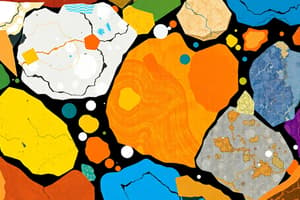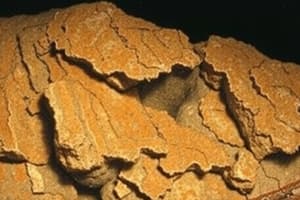Podcast
Questions and Answers
What is the primary process by which underground water contributes to mineral vein formation?
What is the primary process by which underground water contributes to mineral vein formation?
- Creating pressure that transforms existing minerals into new crystalline structures.
- Heating adjacent rocks to induce chemical reactions that form new minerals.
- Transporting dissolved minerals into cracks and fissures where they precipitate out. (correct)
- Dissolving existing rock formations to create space for new minerals.
The rock cycle describes the process by which all rocks on Earth are perpetually melted and reformed into new igneous rocks.
The rock cycle describes the process by which all rocks on Earth are perpetually melted and reformed into new igneous rocks.
False (B)
How do geologists classify rocks, considering both composition and formation?
How do geologists classify rocks, considering both composition and formation?
mineral combination and formation process
The textures of igneous rocks vary based on cooling rate and ______.
The textures of igneous rocks vary based on cooling rate and ______.
Match each type of sediment with its primary mode of transportation:
Match each type of sediment with its primary mode of transportation:
What key factor determines the arrangement of mineral grains in a metamorphic rock that exhibits foliation?
What key factor determines the arrangement of mineral grains in a metamorphic rock that exhibits foliation?
Contact metamorphism typically results in large-scale changes across vast regions, affecting the overall geology of multiple areas.
Contact metamorphism typically results in large-scale changes across vast regions, affecting the overall geology of multiple areas.
What is the primary force that compacts sediments over time to initiate the process of lithification?
What is the primary force that compacts sediments over time to initiate the process of lithification?
The precipitation of mineral crystals from saline water leads to the formation of ______ sedimentary rocks.
The precipitation of mineral crystals from saline water leads to the formation of ______ sedimentary rocks.
Match the terms with the correct descriptions:
Match the terms with the correct descriptions:
How do variations in cooling rate influence the crystal size and appearance of igneous rocks?
How do variations in cooling rate influence the crystal size and appearance of igneous rocks?
Sedimentary rocks must always consist of multiple layers of distinctly different types of sediment.
Sedimentary rocks must always consist of multiple layers of distinctly different types of sediment.
What role do processes like wind, water, and ice play in the formation of sedimentary rocks?
What role do processes like wind, water, and ice play in the formation of sedimentary rocks?
During metamorphism, if a rock melts completely and then cools, it will form a(n) ______ rock.
During metamorphism, if a rock melts completely and then cools, it will form a(n) ______ rock.
Match each term with its description:
Match each term with its description:
How does the composition of the original 'parent' rock influence the minerals that form during regional metamorphism?
How does the composition of the original 'parent' rock influence the minerals that form during regional metamorphism?
Only living organisms contribute to the erosion and weathering processes that break down rocks into sediments.
Only living organisms contribute to the erosion and weathering processes that break down rocks into sediments.
What role does water play in the cementation process during the lithification of sedimentary rocks?
What role does water play in the cementation process during the lithification of sedimentary rocks?
When calcite is deposited in alkaline-rich water forming tufa towers, as seen in Mono Lake, this is an example of mineral formation due to ______.
When calcite is deposited in alkaline-rich water forming tufa towers, as seen in Mono Lake, this is an example of mineral formation due to ______.
Match each rock type with its environment of formation:
Match each rock type with its environment of formation:
Flashcards
Mineral Formation (Igneous)
Mineral Formation (Igneous)
Minerals form when lava and magma cool and solidify.
Mineral Formation (Solutions)
Mineral Formation (Solutions)
Minerals can form when elements in solutions, such as oceans, combine.
Rock Definition
Rock Definition
A naturally formed, non-living Earth material, usually composed of multiple minerals.
Rock Cycle
Rock Cycle
Signup and view all the flashcards
Igneous Rocks
Igneous Rocks
Signup and view all the flashcards
Sedimentary Rocks
Sedimentary Rocks
Signup and view all the flashcards
Metamorphic Rocks
Metamorphic Rocks
Signup and view all the flashcards
Cooling and Crystallization
Cooling and Crystallization
Signup and view all the flashcards
Wind and Erosion
Wind and Erosion
Signup and view all the flashcards
Metamorphism
Metamorphism
Signup and view all the flashcards
Sediments
Sediments
Signup and view all the flashcards
Lithification
Lithification
Signup and view all the flashcards
Cementification
Cementification
Signup and view all the flashcards
Foliation
Foliation
Signup and view all the flashcards
Contact Metamorphism
Contact Metamorphism
Signup and view all the flashcards
Regional Metamorphism
Regional Metamorphism
Signup and view all the flashcards
Study Notes
- Minerals can form from cooled lava and magma after rocks melt due to extreme heat.
- The Earth's oceans contain elements that can combine to create minerals.
- Salt water solutions can create mineral precipitates like calcite, which is deposited in alkaline-rich water such as Mono Lake in Canada.
- Calcite tufa towers form when water bubbles up into alkaline lakes, and are revealed when lake levels drop.
- Underground water, heated by the Earth, can deposit minerals in cracks in the ground, forming veins.
Rocks
- The rock cycle involves the transformation of one type of rock into another.
- Rocks are naturally formed, non-living Earth materials composed of various minerals, sometimes too small to see.
- Rocks are named based on their mineral composition and how those minerals came together.
- Geologists study rocks.
- Igneous rocks form when magma cools, either on the Earth's surface or deep within the crust.
- Sedimentary rocks are created when sediments, such as gravel, sand, silt, or clay, are compacted together.
- Metamorphic rocks are formed when existing rocks are altered by heat and pressure, causing the minerals to change without melting.
Rock Cycle Process
- Rocks can form from processes such as volcanic eruptions or sediment compaction.
- Any type of rock can transform into another over extended periods.
- All three rock types (igneous, sedimentary, and metamorphic) are interconnected.
- Cooling and crystallization can change rocks
- Wind, erosion, ice, plants, and animals can all cause rocks to change and erode.
- Metamorphism occurs when rocks are exposed to high temperatures and pressures, but do not completely melt.
- Metamorphism can lead to new mineral compositions or textures in rocks.
Igneous Rocks
- Igneous rocks are abundant and constitute a significant portion of Earth's crust.
- The appearance of an igneous rock depends on the cooling rate and size of the magma.
- Sediments, such as sand, are fragments of rocks and minerals of varying sizes.
- Sediments must be tightly packed together to form sedimentary rocks.
- Sediments can contain fossils trapped in layers.
- Sediments can be transported by wind, water, ice, or gravity and are deposited in new locations.
- Sediments eventually settle out of water, forming horizontal layers.
- Rivers deposit sediment along their banks when they slow down.
- Clastic sediments are formed by compaction, while chemical sediments form when mineral crystals precipitate from saline or salt water.
Lithification of Sedimentary Rocks
- Sandstone is a rock formed through weathering and erosion.
- Clastic rocks are composed of sediments called clasts.
- Lithification is the process of creating rocks from sediments.
- Chemical sedimentary rocks form when chemicals precipitate from liquids.
- Over time, deposited sediments can harden into rocks through compaction and cementation.
- Compaction occurs when sediments are squeezed together by pressure and weight.
- Cementation involves minerals filling the spaces between loose sediment particles, originating from water moving through the sediment.
- Chemical sedimentary rocks form when crystals precipitate out of liquid, such as the formation of halite (rock salt) from evaporated salt water.
- Cementification occurs when mineral-rich water fills gaps between sediment particles.
Metamorphic Rocks
- Metamorphic rocks always start as another type of rock.
- During metamorphism, ions move in or out of a mineral, creating a different material that is more stable in the new environment.
- Extreme pressure can cause physical changes, such as foliation.
- Foliation is the layering of rock caused by pressure applied to one side.
- Rocks subjected to pressure from all sides usually show no foliation.
- Contact metamorphism occurs when magma comes into contact with a rock, and the magma's heat alters the rock without melting it.
- Regional metamorphism occurs over a wide area.
- Great masses of rock are exposed to pressure from overlying rock and sediment layers.
- Tectonic plate movements can also compress rock.
- Metamorphism does not completely melt the rock but causes mineral changes.
- If the rock melts, it will cool to become an igneous rock.
- Hornfels, displaying alternating colors of dark and light crystals, exemplifies how minerals rearrange themselves during metamorphosis.
Studying That Suits You
Use AI to generate personalized quizzes and flashcards to suit your learning preferences.




